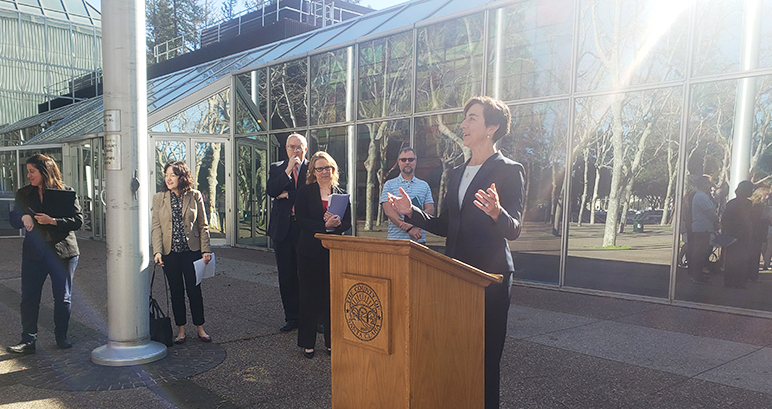When San Francisco 49ers cornerback Richard Sherman cut a $7,500 check two months ago to clear lunch debt at Santa Clara’s Cabrillo Middle School, the headlines applauded his generosity. And rightfully so.
But that’s just part of the story.
News coverage of Good Samaritans footing bills for unpaid school meals overwhelmingly celebrates the gifts without challenging systemic realities that create a need for them in the first place. Left largely unanswered is the question of why, in one of the wealthiest regions of the wealthiest nations, is lunch debt at public K-12 schools even a thing?
A growing coalition of local policymakers say it shouldn’t be. At least not for the neediest schools in Silicon Valley.
With that in mind, the Santa Clara County Office of Education, Second Harvest of Silicon Valley and the YWCA of Silicon Valley are coalescing behind an initiative to provide universal meals at up to 84 campuses in 17 local school districts.
Come Tuesday, Santa Clara County Supervisor Susan Ellenberg will pitch the idea to her colleagues on the five-member Board of Supervisors. The proposal co-sponsored by Supervisor Joe Simitan would direct the county to explore the feasibility of spending $8 million to feed 12,000 impoverished kids over the next four years.
That breaks down to 60 cents a plate.
“From this action tomorrow, we can see more kids in school, we can know that they’ll behave better—which is not only in their interest but the interest of every kid in the classroom—and that they’ll learn more,” Simitian said at a Monday morning press conference. “I can’t do anything except expect a 5-0 vote. That is my hope.”

County Supervisor Susan Ellenberg unveiled her universal meals plan to reporters Monday. (Photo by Jennifer Wadsworth)
In a policy memo detailing the plan, Ellenberg describes how the county plays a vital role in addressing child hunger by administering CalFresh and nutrition programs for women and infants. But federal rule changes designed to dissuade undocumented immigrants from accessing safety net services has made it increasingly difficult for the county to extend support to families in need, the memo goes on to state.
The U.S. Department of Agriculture began offering additional funding in 2015 for high-poverty schools to provide universal meals to K-12 students. Yet in the five years since launching the program, just half of eligible campuses nationwide have taken advantage of the reimbursements because they lack the up-front resources to get started.
In California, only 15 percent of qualified schools have availed themselves of the financial boost—the third lowest state participation rate in the nation.
It’s not for a lack of need.
Just 68 percent of students poor enough to qualify for subsidized school lunches in Santa Clara County are signed up for them. Only 35 percent of students eligible for school breakfast take advantage of the program. According to local school officials, that leaves nearly 30,000 children countywide without midday meals and 55,000 without breakfast.
“In the midst of so much plenty,” Second Harvest CEO Leslie Bacho lamented, “we still see so many people struggling to make ends meet.”
As Simitian sees it, three barriers stand between eligibility and access: bureaucracy, fear and stigma. Extending meals to all students at high-poverty schools counteracts those factors, he said, by eliminating the paperwork and assuaging concerns among immigrant families about information being shared with federal authorities.
That certainly held true during Ellenberg’s tenure as a San Jose Unified School District trustee when she took part in an effort to encourage more families to sign up for meal subsidies. Instead of assigning SJUSD staff to single out only eligible families, the district required all households to submit applications for the program. The plan worked, to some extent, upping participation rates by about a third.
“But we still had that gap,” Ellenberg recounted.
Now, halfway through her first term as county supervisor, she’s taken up the cause once more. This time, by assembling a coalition of public agencies and non-profits to tackle the problem from multiple angles.
Santa Clara County Office of Education Superintendent Dr. Mary Ann Dewan applauded the effort, saying it will likely translate to fewer skipped school days and stronger academic performance. “A core component of health is nutrition,” Dewan said Monday. “We all know that regular school attendance promotes achievement.”
The Santa Clara County Board of Supervisors meets at 9:30am Tuesday at 70 W. Hedding St. in San Jose. To peruse the entire agenda, click here.


Excellent idea. Would eliminate or significantly reduce any sense of stigmatism for some children who are too poor to otherwise buy their lunches.
> Excellent idea. Would eliminate or significantly reduce any sense of stigmatism for some children who are too poor to otherwise buy their lunches.
Why are you so miserly that you only want to feed a few thousand people in Santa Clara County?
Why not provide “universal meals” to all seven billion people on the planet?
My heart is bigger than your heart. I care more.
LOL,
You should run for office!
If they become citizens…THAT IS THE WAY TO GO…AND THEY NO ONE WOULD SAY…NO TO ILLEGALS IMO
> Left largely unanswered is the question of why, in one of the wealthiest regions of the wealthiest nations, is lunch debt at public K-12 schools even a thing?
Jennifer:
You failed accounting, didn’t you.
The answer to your “largely unanswered question” is: we’re NOT one or the wealthiest nations; we’re TWENTY ONE TRILLION DOLLARS IN DEBT!
We’re the poorest, most destitute human society the planet has ever seen.
At some point in time, the interest payments to the money lenders will exceed all of the wealth produced by the economy.
The money lenders will be the only people eating “universal meals”. Everyone else will have to re-learn cannibalism.
should start screening Soylent Green – – a classic film that should be required viewing in every gov’t office and at least once a week to very human being that thinks that reproduction of themselves is some kind of blessing to humanity https://en.wikipedia.org/wiki/Soylent_Green
The school free and reduced breakfast/lunch program has been around for decades. Why do you need more taxpayer money?
If people are not paying their bills, they should be held accountable. If they qualify for free meals, they need to sign up. If they qualify for reduced meals, they need to pay their share. Why do we need to further subsidies them?
If the problem revolves around people who aren’t eligible for other reasons, that’s a different issue entirely and still should not demand more money.
Come to Santa Clara county where everything is free, housing, food. education , illegal immigration and working is optional.
Glad I don’t live in Cali….so I live in nj…where a demo is in office
Well welcome to the club….I want to get out of Paradise…but the apts are over 2000 and up
I see some Russian BOTs here sowing disharmony and holier than thou attitudes….We are talking about children, for Christ sake. And it may very well be that their parents are barely able to pay the rent, which keeps going up…
> and holier than thou attitudes….
Speaking of “holier than thou attitudes”, I discern a tad bit of holiness supremacism in your moralizing about assigning me the responsibility for feeding other people’s children.
You feel good about yourself, don’t you. And it didn’t cost you a nickle.
Our schools have become the new Orphanages: morning to evening government (taxpayer) complete care. Can overnight stays be far behind? Oliver Twist eat your heart out!